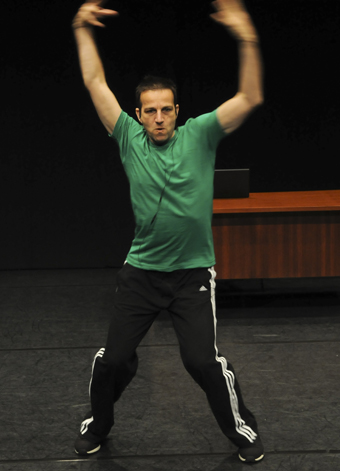 |
Gideon Obarzanek, Faker photo Heidrun Löhr, courtesy Sydney Opera House |
Faker addresses us, the audience, as an autobiographical, even confessional work, but it is impossible to discuss it as such—once it enters stage space and stage time, 'Gideon Obarzanek' stands for Gideon Obarzanek, performing a sitting that stands for sitting, at a desk standing for a desk. It would be dramaturgically and critically naive to review ad hominem: this review can only talk about a staged character, 'Gideon Obarzanek,' not the person off-stage; and about the stage letter he receives from a theatrical pupil. The question of the percentage of ‘reality’ involved is, in this case, at the very least dumb, and at the very worst unethical.
The dramatic structure has 'Obarzanek' alternating between two activities: first, he reads out a letter sent to him by a young dancer, clearly smitten by 'Obarzanek,' who initiates a collaboration, hoping that he will “bring out the fabulous” in her, and then finds herself feeling progressively more vulnerable, let down, and growing increasingly more disappointed, hostile. The voice of the letter sounds clear notes of adoration, insecurity, need to be liked and desire to please, and although it is said to belong to a woman, it could easily belong to a young man. Asked to perform something she has not done before (“this task was designed in a way that I could only fail”), her insecurity starts coalescing into a perception of betrayal: “I stood there, humiliated.”
Between the paragraphs, 'Obarzanek' dances. Or rather, performs his pupil’s dancing: some excruciatingly clumsy moves with bad singing, something-she-has-never-done-before, a randomly arranged ‘conceptual’ sequence, and the solo he choreographed for her, the only one she liked: it required skill, she writes, and it belonged to her. The dancing is uproariously bad—we are certainly invited to laugh. Whether we are laughing at the dancer or at 'Obarzanek' is a very good question. Something-she-has-never-done-before is a case to consider: 'Obarzanek' sets an alarm, forcing himself into a long series of unprepared, unrehearsed, silly-looking movements. At this point it seems like he may be pushing himself through the humiliation he imposed onto the young dancer, tasting her powerlessness by having to endure until the alarm releases him. A few minutes later, the alarm goes off again, and 'Obarzanek' needs to interrupt the performance for a second to turn it off. He makes a quick, embarrassed joke to the audience, explaining the error with a short nervousness that is quite at odds with the precise, even angry focus with which the rest of the work is delivered. This incident reveals that there is no vulnerability to 'Obarzanek’s' performance. Rather, a sort of resentful fatigue, visible in the corners of his mouth and the detached raising of his eyebrows as he continues to narrate.
The two characters are full of resentment, with bitter accusations on one side and a strong defensiveness on the other. The hostility between them is high and charged with sexual tension—the dancer accuses the choreographer of choreographing on her another one of his “ongoing sensual-woman solos”. Every teacher-student relationship is intrinsically erotic, and dirty laundry flies in all directions. The dancer calls 'Obarzanek' “one of those pervy directors”; he exposes her weaknesses, of artistry and character, to a staggering extent. The rapport between a famous, older, male choreographer and a young, inexperienced female and clearly adoring dancer is one of enormous inequality, let's make it clear, and the choreographer takes no precautions to protect his pupil, neither in the rehearsal process nor in the performance.
What intrigues is the differences between their voices. The female dancer is capable of softness, a conspiratorial intimacy: she apologises, she deliberates, she explains herself, she thanks him. The male choreographer shows no such concern: to her accusations of not living up to her expectations of him, to his status, all he offers is an admission that he, too, doubts himself. There is no empathy with the young dancer's vulnerability, and no willingness to respond. Obarzanek as 'Obarzanek' performs wounded masculine pride to perfection. While the dancer admits to lying, to having nightmares, to doubting herself, to feeling humiliated, 'Obarzanek' never appears to hear the charges levied at him. What he admits, instead, is recognising the doubt in the dancer’s demeanour—a doubt he has grown to notice, and ostensibly fear, but not to address. A wide gulf separates his control of the stage from the vulnerability of, for example, Jerome Bel allowing Pichet Klunchun [in Pichet Klunchun and Myself] to question him on stage, in person, named.
Faker is not a dialogue. 'Obarzanek' appropriates his accuser’s voice, turning a critique of himself into a long monologue. The irony is unmistakeable: if he had great power over the dancer's body as her choreographer, as the re-interpreter of his own choreography for her he colonises her completely; she remains on stage only in faint traces. It is almost as if he is taking away from her the only thing she took from him gladly: her solo. A solo which, performed against a Baroque chorale and churchlike lighting, seems to make a heavy-handed point about 'Obarzanek’s' qualities as a choreographer and dancer, a coup de grace in a fight that was unequal from the start.
If this is self-critique, it is one with in-built clemency.
Dance Massive: Gideon Obarzanek, Faker, concept, choreography, performance Gideon Obarzanek, lighting designers Gideon Obarzanek, Chris Mercer, creative consultants Aimee Smith, Lucy Guerin, Antony Hamilton, Tom Wright, Malthouse, Melbourne, March 23-April 2; www.dancemassive.com.au
© Jana Perkovic; for permission to reproduce apply to [email protected]








 back
back